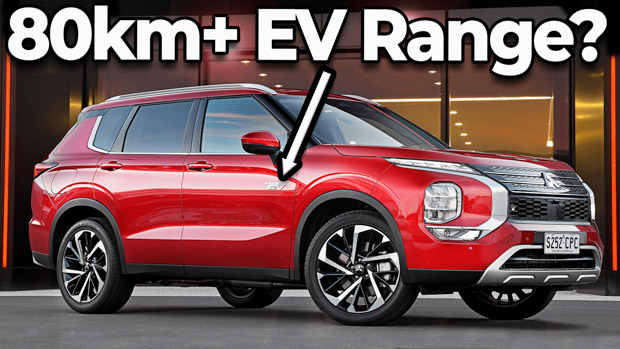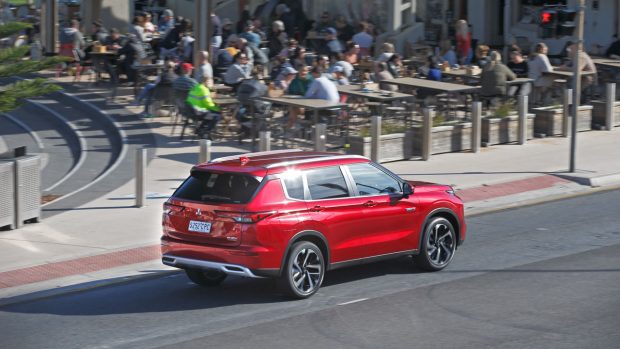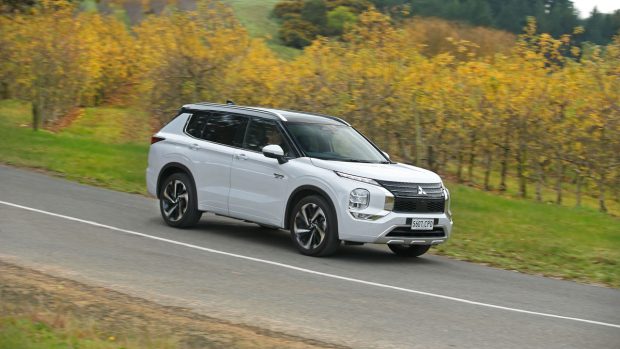-
Car Reviews
- All reviews
- Midsize SUVs
- Small cars
- Utes
- Small SUVs
- Large SUVs
- Large cars
- Sports SUVs
- Sports cars
- Vans
Latest reviews
- Car News
-
Car Comparisons
Latest comparisons
- Chasing Deals
The Outlander’s ride and handling still isn’t perfect, but the new plug-in hybrid takes the driving experience to new levels of pace and refinement

Mitsubishi’s new Outlander arrived on Australian shores in October 2021, shocking motoring media with its handsome design, affordable pricing, slick interior and generous cabin space. Unfortunately, its asthmatic Nissan-derived atmo-petrol four-cylinder and fitment of ride-compromising 20-inch alloy wheels on the up-spec variants left us at Chasing Cars a little cold on Mitsi’s midsize SUV.
The previous Outlander’s notoriety came from the plug-in hybrid model that debuted in 2013 – famously a best-seller for many years and the first-ever PHEV SUV. Now, the new Outlander PHEV trails its petrol-only counterpart’s Australian arrival by nine months, priced between $54,490-68,390 before on-road costs.
Mitsubishi has been fervently improving the entire Outlander PHEV experience with revisions to the 2.4-litre petrol engine that now develops 4kW more power and runs in both Atkinson and Otto compressions cycles. There’s also an all-new 40 percent more powerful front electric motor and a rear motor that develops 100kW/195Nm from a 50 percent smaller package, meaning a seven-seat Outlander PHEV is available for the first time.

The drivetrain itself is improved, with smoother operation of the single-speed planetary transmission. Mitsubishi has also increased electric-only range by 48 percent (to 84km) thanks to a larger 20kWh lithium-ion battery, making the new Outlander PHEV an even more eco-friendly option.
The catch? The Aspire Plug-in now commands a $15.5K premium over the petrol car.
There’s no secret that the world is transitioning to EVs. But in Australia, with further distances to travel and a lack of consistent policy federally that transition is being smoothed by hybrid vehicles. Aussies seem to love hybrids, certainly the Toyota RAV4. And while some malign this technology for being a transitional one, that hasn’t bothered Mitsubishi Motor Australia Limited (MMAL).

CEO of MMAL, Shaun Westcott, admitted himself that PHEV is one step on the brand’s journey in electrification. Owners of the previous Outlander hybrid surveyed completed 84 percent of their travel on electric power alone, and as Westcott put, that’s undeniably cutting tailpipe emissions on the way to full electrification.
Our route wound from Mitsubishi’s HQ near Adelaide airport through the ‘City of Churches’ for about an hour before climbing up Gorge Road to the Mount Lofty Hotel. A typical weekend route that the Outlander plug-in hybrid took (mostly) in its stride.
Unlike one of the Outlander’s key rivals – such as the Ford Escape plug-in hybrid, for one – the eco take on the Outlander is far more powerful than its petrol-only counterpart. The PHEV’s pair of electric motors boost the Outlander’s total maximum outputs to 185kW/450Nm.

Those are huge improvements over the 135kW/245Nm 2.5-litre direct-injected naturally aspirated four-cylinder. This helps mask the atmo’s wheezy note in regular driving with electric motors being adequate for the circa two-tonne Outlander to keep up with normal traffic.
If you want to access the Outlander’s maximum grunt, you’ll need to twist the seven-position rotary drive mode selector around from ‘Normal’ to either ‘Tarmac’ or ‘Power’. This unleashes everything from the Outlander, for a claimed 0-100km/h sprint time of 8.2 seconds.
The all-wheel-drive Outlander PHEV differs from the ICE car as there is no physical connection between the axles. The front wheels are powered by either the electric motor or petrol engine via a revamped, stronger single-speed transmission, while the rear gets direct drive from an electric motor (just like a Toyota RAV4 hybrid).

The result is great traction and instant drive from the rear, with no scrabbling front wheels first before redirecting torque. This was put to the test on the technical roads around the Adelaide hills, including on dirt, where the AWD Outlander performed admirably. Off-road modes including ‘Gravel’, ‘Snow’ and ‘Mud’ adjust power preference, throttle response and ESC calibration to suit conditions.
Mitsubishi has managed to maintain the Outlander’s 1600kg braked towing capacity, marginally better than an AWD RAV4 Hybrid (1500kg) and Peugeot 3008 PHEV (1250kg).
When it comes to ride and handling, the latest Outlander is not as far ahead of its predecessor as when it comes to interior fit, finish, technology and polish. When fitted with 20-inch alloys, the petrol car has an unpleasant mix of aloof body control and abrupt secondary ride, especially around town.

Despite weighing about 380kg (depending on variant) more, the PHEV actually improves things. There is still plenty of body movement, leading to nearly bottoming out over speed humps, but the dampers’ high-speed control felt better. The Outlander PHEV definitely leaned toward the plush side, especially in ES guise on 18-inch alloys with chubby sidewalls.
You do feel the Outlander’s weight in corners eventually, but the low-slung nature of the battery means this midsize SUV mostly retains composure. The light and sharp steering rack makes the PHEV feel wieldy and is talented enough to tackle country roads.
Using the revamped regen braking is also great. There are now six levels – five controllable by the steering wheels-mounted paddles, and a one-pedal mode. The maximum decelerative force is up to 0.2G (from 0.1G), and means with planning you can just about pull up to a set of lights without brushing the brake pedal.

The Outlander PHEV was awarded five stars across the range in ANCAP’s 2022 protocol. Crucial features such as front AEB with pedestrian, cyclist and junction protection, lane-keep assist, reverse AEB, blind-spot monitoring are all present.
Mitubishi’s driver aids – adaptive cruise control, lane-trace assist and 360-degree camera – are impressive too. The implementation is better than Toyota’s and about on par with a Kia Sportage or Hyundai Tucson.
If on paper it seems like the Outlander to have is the quilted leather-smothered Exceed Tourer, that’s not really the case, especially when saddled with near $16K of plug-in hybrid premium. The Tourer’s $68,490 price tag puts that car in the realm of an Audi Q5 40 TDI ($69,900) and while this Mitsubishi is classy, it isn’t truly premium.

That means you get more value in the middle of the Outlander range, but even the ES base model’s cloth upholstery feels relatively upmarket. The ES’s fleet sale pitch means you’re more likely to get this variant as a rental car (and be rather happy about it) than a middle-class family truckster.
Ultimately, the everything-you-need-and-nothing-you-don’t Aspire is probably the one to have. Its suedecloth-accented seats still feature power adjust for the driver and three-stage heating for both front occupants for $60,990. The only major reason to jump up to the Exceed is the leather upholstery and nine-speaker Bose sound system that offers greater clarity than the Aspire’s audio system.
All plug-in hybrids get the 12.3-inch digital driver’s display and crisp 9.0-inch touchscreen featuring wireless Apple CarPlay and Android Auto connectivity as well as Qi wireless charging. The Outlander has one USB-A and one faster USB-C charge point in the front cabin.

Interior storage is generous in the Outlander with large cupholders, generous door bins and covered cubby beneath a softly padded centre armrest. Material quality is generally high with the dimpled leather-appointed steering wheel a highlight to hold.
The Outlander’s cabin is user friendly; that steering wheel has helpful shortcut buttons; the conventional gear shifter is easier to wrap your head around than the Ford Escape’s rotary item, and there are physical HVAC controls too.
In the second row, the Outlander does suffer from its battery packaging. The floor sits higher in the PHEV making the rear bench a little less comfortable for my 188cm frame. Headroom and legroom are still plentiful, but the lack of toe room wasn’t ideal. At least the doors are softly padded and there are two air vents in the back to keep passengers cool.

An added benefit of the new Outlander PHEV is its five-plus-two seating configuration in Exceed or Exceed Tourer. The seats themselves aren’t adult friendly, but it’s impressive packaging nous from Mitsubishi to offer seven seats in a midsize SUV – only really the Skoda Kodiaq manages the same feat in Australia and that car doesn’t have a lithium-ion battery and electric motor to worry about.
Cargo space for the five-seat Outlander PHEV variants is 485 litres, while the seven-seaters are slightly lower in two-row configuration (478L) with enough space for school bags in seven-seat mode (163L). There is sadly no spare tyre, though Mitsubishi does handily include a place to store both charging cables that come with the Outlander.
Mitsubishi has also made a big deal about the Outlander’s electric credentials, and not just for driving. In the boot there’s a 240V, 1500W three-pin socket providing enough power to make an espresso coffee, charge a laptop or keep a portable fridge cool.

There is also vehicle-to-grid and vehicle-to-load capability baked into the new Outlander. This means that if you have excess electricity, it can be returned to the grid (using a two-way Wallbox Quasar, not approved just yet for Australian use) or to power buildings in emergency situations. This aspect of EV technology is still in development, but could prove crucial in the future according to Mitsubishi.
The concept of a plug-in hybrid is complex. An EV is a simple beast to understand, and while convoluted in construction, a self-charging hybrid can be evaluated in a similar way to a normal combustion-engined vehicle with a fuel economy bonus.
Instead, the plug-in requires the owner to make an effort to get the best of it, something that Outlander owners are already doing. Of owners surveyed, Mitsubishi Australia found the average weekly driven distance was 155km, and of that owners would travel 84 percent of that distance on electric power alone.

Additionally, Mitsubishi found almost all owners charged their Outlander at home, either using electricity from the grid or home solar.
So while the new Outlander’s circa-38kW Chademo public fast-charging capability is handy – recuperating 80 percent of its 20kWh charge in 38 minutes – it’s unlikely this will be a regular choice for owners.
Instead, charging at home or at a place of work is the PHEV default. On a domestic 240V three-pin socket, a full charge of the Outlander’s battery will take 9.5 hours. A 7kW wallbox will drop this time to 6.5 hours.

With a full charge, the ADR-rated fuel consumption for the Outlander is 1.5L/100km. Using ‘Normal’ mode with a combination of EV-only and hybrid running we saw 5.6L/100km in an hour-long urban loop.
Electric-only range for the Outlander is quoted at 84km according to the combined ADR test procedure. The energy efficiency to achieve that figure is 25.7kWh/100km and in electric-only mode our test subject achieved better: 23.7kWh/100km.
Mitsubishi’s capped-price servicing runs for 10 years, but for ease of comparison to rivals, five-years/75,000km of maintenance will cost $1495. That’s a little dearer than the Toyota RAV4 ($1150) but on par with a Ford Escape PHEV ($299/visit for four years) and a lot cheaper than the Peugeot 3008 PHEV ($3108).

Additionally, the Outlander is covered by Mitsubishi’s 10-year/200,000km warranty providing it is serviced at Mitsubishi dealers. The 20kWh battery is covered by its manufacturer’s eight-year/160,000km warranty.
To reap the rewards of a plug-in hybrid powertrain requires a diligent owner, one who will keep the battery charged to make the most of the possible zero-emissions motoring.
It is certainly a transition technology on the way to full electrification, but without the range anxiety of a battery EV it’s one that undeniably suits Australia’s long distances.
Even though the Outlander Aspire PHEV is $15.5K dearer than petrol equivalent, it seems like a sharper buy than the regular car. The ride of the PHEV is improved, it’s more efficient in the real-world and the Outlander finally has enough power to get out of its own way.
The Exceed Tourer’s plush cabin is undeniably attractive, but at $68K it’s an expensive mainstream SUV. Instead it was the Aspire – or base model ES – that resonated most with us on launch. The Aspire has just enough luxury, without being absurdly expensive.
Key specs (as tested)
About Chasing cars
Chasing Cars reviews are 100% independent.
Because we are powered by Budget Direct Insurance, we don’t receive advertising or sales revenue from car manufacturers.
We’re truly independent – giving you Australia’s best car reviews.
The estimate provided does not take into account your personal circumstances but is intended to give a general indication of the cost of insurance, in order to obtain a complete quote, please visit www.budgetdirect.com.au. Estimate includes 15%^ online discount.
^Conditions Apply
Budget Direct Insurance arranged by Auto & General Services Pty Ltd ACN 003 617 909(AGS) AFSL 241 411, for and on behalf of the insurer, Auto & General Insurance Company Limited(ABN 42 111 586 353, AFSL 285 571).Because we don’t know your financial needs, we can’t advise you if this insurance will suit you. You should consider your needs and the Product Disclosure Statement before making a decision to buy insurance. Terms and conditions apply.
Indicative quote based on assumptions including postcode , 40 year old male with no offences, licence suspensions or claims in the last 5 years, a NCD Rating 1 and no younger drivers listed. White car, driven up to 10,000kms a year, unfinanced, with no modifications, factory options and/or non-standard accessories, private use only and garaged at night.
^Online Discounts Terms & Conditions
1. Discounts apply to the premium paid for a new Budget Direct Gold Comprehensive Car Insurance, Third Party Property Only or Third Party Property, Fire & Theft Insurance policy initiated online on or after 29 March 2017. Discounts do not apply to optional Roadside Assistance.
2. Discounts do not apply to any renewal offer of insurance.
3. Discounts only apply to the insurance portion of the premium. Discounts are applied before government charges, taxes, levies and fees, including instalment processing fees (as applicable). The full extent of discounts may therefore be impacted.
4. We reserve the right to change the offer without notice.